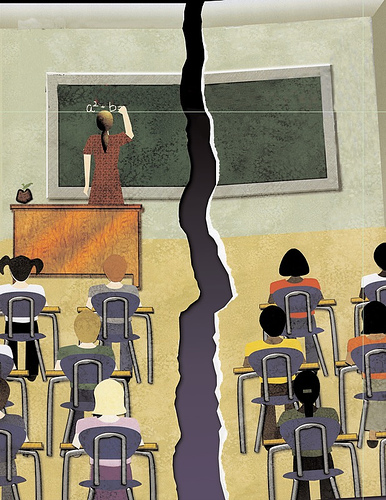 Last night the Davis Joint Unified Board of Education discussed the achievement gap, along with newly-released data from the Academic Performance Index. There was good news and bad news to report. The good news is that overall, the district remains in good shape with a strong showing. There seem to be very small but real gains made by some of the subgroups that have performed at a lower level in the past. However, there are a lot of findings to be concerned about. The district remains concerned about the achievement gap, and while they cited small progress and the implementation of programs to assist, the progress was not near enough.
Last night the Davis Joint Unified Board of Education discussed the achievement gap, along with newly-released data from the Academic Performance Index. There was good news and bad news to report. The good news is that overall, the district remains in good shape with a strong showing. There seem to be very small but real gains made by some of the subgroups that have performed at a lower level in the past. However, there are a lot of findings to be concerned about. The district remains concerned about the achievement gap, and while they cited small progress and the implementation of programs to assist, the progress was not near enough.
For the district, overall, there was a good deal of good news to report. Korematsu became the latest school to join the 900 club, which is an elite level where 1000 is the maximum score. APIs of all of the Junior Highs are scoring around 890. The district overall has an 877 score, which was up six points from last year.
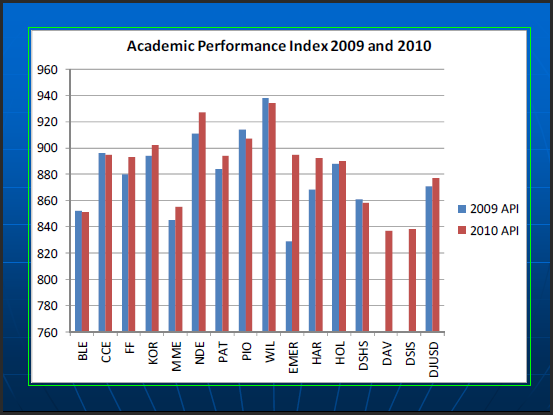
All schools are over 800, which is the minimum by No Child Left Behind standards. However, Clark Bryant, Associate Superintendent, did indicate that Superintendent of Public Instruction Jack O’Connell wants to raise the threshold to 860, which would still put the district in good standing, but by a much narrower margin.
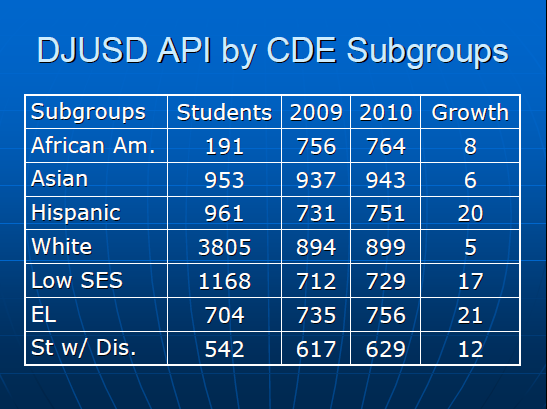
There is some modest growth in the subgroups, as measured by API. It was reported earlier that this marked a shrinking of the achievement gap. It is a very small closing at best. As measured by API, there was a 138-point gap last year between white and African American students, and that gap fell to 135 this year. For Hispanics, the gap was 163 last year compared to 148 this year.
Asians have a large gap on white students. Asians are scoring an amazing 943, compared to a very good 899 for whites (remember 900 puts schools into an elite level of performance). Whereas, neither African Americans, Hispanics, Low SES, EL (English Learners) or students with disabilities are even making the 800 level that is the bare minimum for a school district. There is a small closing of the gap, particularly for Hispanic students, but it is still a concern.
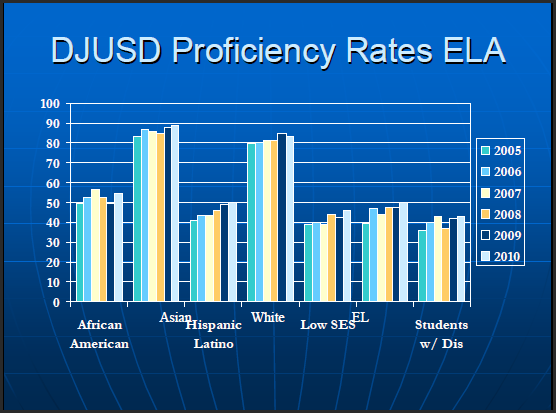
You can see the trend for each of the subgroups as it pertains to English Language Arts. Again, only Asians and Whites are over the 80-percent proficiency mark.

This illustrates the problem. Even as Hispanics have improved their scores over time, they have moved from being in the good standing range to not making the No Child Left Behind (NCLB) target.
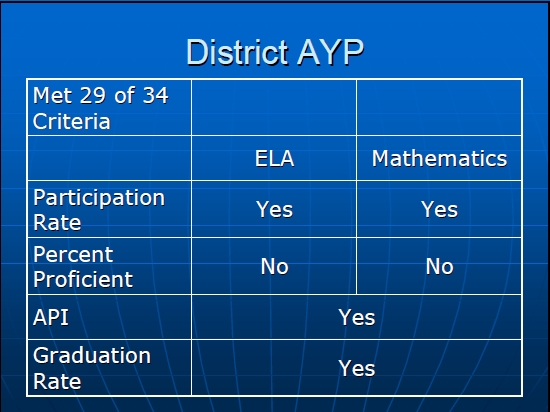
This district is meeting AYP in 29 of 34 criteria, and it is meeting the 95% participation rate, but there are several categories where the percent proficient (you can see in the above slides which ones those might be) is not high enough.
The board also had a discussion of what happens when a school falls into the Program Improvement (PI) category. The good news is that only Montgomery is in that category this year, but that may change in the next year. A school falls into that category if for two years the same group is not making AYP (Average Yearly Progress) in the same content areas. Once that happens, the school must make AYP for all targets to get out of the PI category.
In the first year, the district has to allow parents the choice of whether or not transfer to a different school site. In the second year, they have access to supplemental educational services. Different vendors can get a contract from the outside to provide tutoring services. This takes up about 21% of the district Title I money and provides roughly $920 per pupil for tutoring in order to help lift scores and improve.
Here is another look at the achievement gap
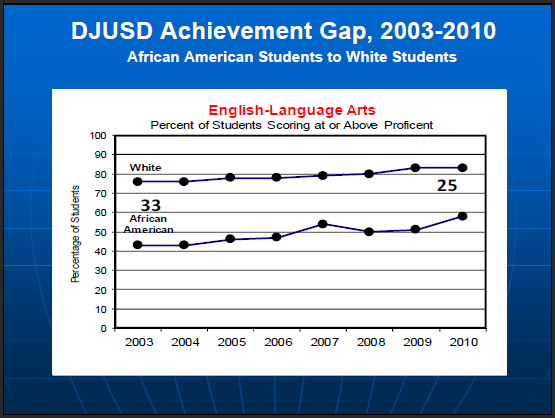
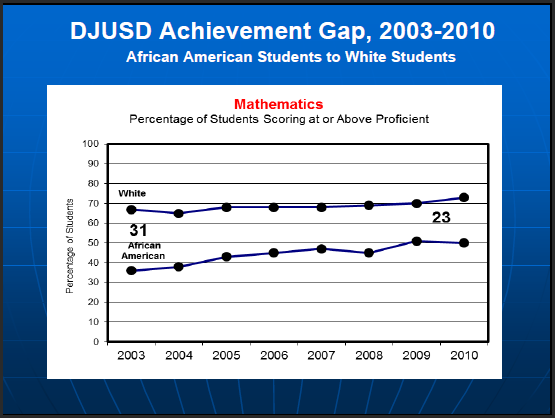
African Americans have made some progress, but as Associate Superintendent Clark Bryant indicated, the progress is not nearly good enough. One of the points he made is that they need to find a way to assess students throughout the year, rather than after the fact through the Star Test. That would provide them with the ability to identify the students who are struggling and get them the type of support and supplemental help that they need.
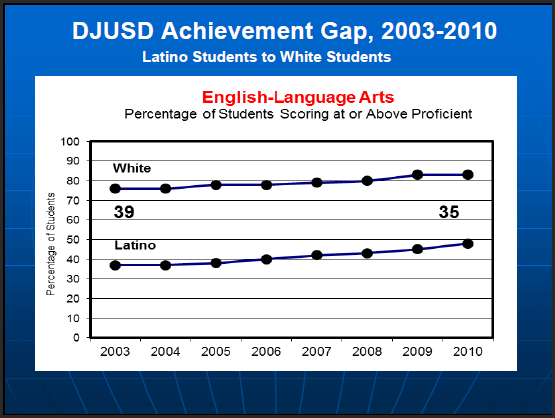

Associate Superintendent Bryant indicated very clearly that what is occurring now in the achievement gap is not enough, and that they have to do more to close the gap. As we can see from this display, Latino Students have closed the gap far more modestly than African Americans. Less than half of Latino Students are achieving proficient scores. Half of African American students are achieving proficient scores in math, and 60% in English.
What was unfortunate is that the school board spent quite some time talking about the graduation rate which is quite high, and the drop-out rate which is quite low. That is certainly good news, but they spent ten to twenty minutes talking about ways to keep the twenty students who drop out during their time from 9th through 12th grade in school. That is fine but it ignores the over 1000 students who fall into the achievement gap and are not making proficient scores.
One issue that I raised during public comment is the fact that we need to understand what we are viewing here is not simply a problem with people who are low SES (Socio-economic status), not simply about lesser-educated homes, not simply about single-parent families, but rather, once these factors are controlled for, there is a separate and distinct racial component.
I think we need to really understand what is going on. The district has a whole list of implemented recommendations and some suggestions about where to go from here. One point Dr. Bryant made was that we need to continue with the current implemented policies rather than continue to change things. But I really would like to understand why there is an achievement gap between the children of college-educated whites versus college-educated blacks and Hispanics.
Until we know that answer, we are just randomly shooting at problems. And I agree with Dr. Bryant, we need to find the students early and give them additional resources and guidance. We are in the process of obtaining more data from the school district and will present that next week as we continue to get at these complex and difficult problems.
—David M. Greenwald reporting

dmg: “I think we need to really understand what is going on. The district has a whole list of implemented recommendations and some suggestions about where to go from here. One point Dr. Bryant made was that we need to continue with the current implemented policies rather than continue to change things. But I really would like to understand why there is an achievement gap between the children of college-educated whites versus college-educated blacks and Hispanics.”
Throwning inordinate amounts of money tilting at windmills will deprive more students of the assistance they need.
dmg: “African Americans have made some progress, but as Associate Superintendent Clark Bryant indicated, the progress is not nearly good enough. One of the points he made is that they need to find a way to assess students throughout the year, rather than after the fact through the Star Test. That would provide them with the ability to identify the students who are struggling and get them the type of support and supplemental help that they need.”
Now this is a solid useful suggestion on how to identify those with learning problems. Once identified, it is important to give these kids the resources needed to help them achieve minimum competency or better.
I don’t understand your first point Elaine. We’re already doing the tests, the state requires them. They found a problem. If we do not solve that problem, we will be forced to spend money by the state and the feds. We have to do it anyway, so why not figure out the problem rather than randomly throwing simple catchall solutions that are not going to work?
One issue that I have observed in the district is that they may not have as many readily-available staff who can speak Spanish to Spanish-speaking parents. That resource would help parents to figure out how to help their kids. EL teachers often are bilingual, but that’s not the case for many other teachers teaching regular classes.
dmg: “I don’t understand your first point Elaine. We’re already doing the tests, the state requires them. They found a problem. If we do not solve that problem, we will be forced to spend money by the state and the feds. We have to do it anyway, so why not figure out the problem rather than randomly throwing simple catchall solutions that are not going to work?”
Doing testing costs money, whether it is federal, state or local. So my complaint is with the testing concept overall. I would much rather take that money and spend it on resources to assist kids having problems with basic competency. I agree with you if the feds are forcing our local schools to do the testing, we have no choice but to test. But a lot of time and energy are being spent chasing down an illusive problem that is probably not something the school system can solve. Better to expend time and energy to address the lack of resources for those with learning problems. The individual instructors working with kids having learning problems will figure out what each individual student’s difficulty is and address it accordingly. This is what special tutoring is all about.
wdf1: “One issue that I have observed in the district is that they may not have as many readily-available staff who can speak Spanish to Spanish-speaking parents.”
Very good point. This is what I am talking about. We spend inordinate amounts of money on testing, which would be better spent towards hiring Spanish speaking staff.
I agree with you on testing in general, but since we are being forced to do it, and it’s not our local money, might as well take full advantage of the opportunity to gain insights.
dmg: “I agree with you on testing in general, but since we are being forced to do it, and it’s not our local money, might as well take full advantage of the opportunity to gain insights.”
Agreed
Very good point. This is what I am talking about. We spend inordinate amounts of money on testing, which would be better spent towards hiring Spanish speaking staff.
Not that easy.
Imagine yourself as a JH/middle school algebra teacher. Do you want to be hired for your skills teaching algebra in English? or should there be a teacher who was preferred for being a native Spanish speaker?
California is not all that politically friendly to accommodating native speakers of other languages. Note the efforts of the recent past to make English the official language, the alarm that goes up when the government caters to speakers of languages other than English.
Additionally, there’s more to communicating in a language than having a few high school/college courses. There are subtleties of respect and trust that are communicated through language that only come about with years of speaking experience. So although a teacher maybe functionally bilingual, it doesn’t always mean that he/she can gain optimal trust of the Spanish speaking parent. Think of how you react toward someone communicating to you in a thick foreign accent vs. someone using familiar slang in a very familiar accent. If you were a Spanish language speaker (as a second language), you would likely speak Spanish, often with a thick accent. Not to denigrate any modest attempt to speak a second language on the part of a professional, it’s just that there is more to successful communication than is usually considered.
I don’t think DJUSD offers any bonus pay for bilingual employees, particularly if represented in the student population. That would be nice, but tends to cut against some broader political views about accommodating non-native residents.
Jeff Hudson article in today’s Enterprise that touches on achievement gap strategies at Patwin Elementary:
[url]http://search.davisenterprise.com/display.php?id=69838[/url]
wdf1: “Not that easy.”
You said “staff”, which I took to mean interpreters, not necessarily Spanish speaking teachers. But it doesn’t matter what resources you use to assist those students who speak English as a second language. Whatever resources are needed will be less if inordinate amounts of money are spent on testing kids to determine the reasons for the “achievement gap”. It doesn’t take a test to understand why Hispanics who speak Spanish as thier first language and English as their second language (if at all) would have learning difficulties that need to be addressed to get them up to minimum competency.
From the article suggested by wdf1: “It’s a situation that educators — both locally and nationwide — have been looking at for years. “Research says that the most important thing (in closing the achievement gap) is a partnership between the teacher, the student and the parent,” said Superintendent Winfred Roberson. “We need all three of those components. In the process of addressing that and delving deeper, we’re exploring strategies to make sure there’s a culture of engagement (at school).”“It’s hard work,” Roberson said. “This is ‘roll-up-your-sleeves’ work. There’s no one to blame. It’s just hard work.”
Now it doesn’t take testing to determine what Roberson is suggesting, just common sense.
The article goes further on to suggest block scheduling which involves grouping kids together by ability level. Egads, we did that in my day!!! This is nothing new – it is an old tried and true method that works. Sounds like Roberson may do an excellent job as the new Supt. It’s about freakin’ time!!!
“The article goes further on to suggest block scheduling which involves grouping kids together by ability level.”
Yes, like … GATE.
You said “staff”, which I took to mean interpreters, not necessarily Spanish speaking teachers. But it doesn’t matter what resources you use to assist those students who speak English as a second language. Whatever resources are needed will be less if inordinate amounts of money are spent on testing kids to determine the reasons for the “achievement gap”. It doesn’t take a test to understand why Hispanics who speak Spanish as thier first language and English as their second language (if at all) would have learning difficulties that need to be addressed to get them up to minimum competency.
I understand that the district pays something like $9/hour to interpret; court interpreters, by contrast, make many, many times that rate. If you are a competent interpreter, a school district is not necessarily a place where you’ll be financing your mortgage and bills. You’re dealing with a budget question (do we “throw money at this problem”?). Many Spanish immersion teachers are indeed very bilingual, and native speakers. But they’ve already got plenty on their plate to deal with (trying to get their very own students meeting performance standards) than to take up extra time interpretting at that rate of pay. Again, I also understand that Spanish Immersion teachers don’t get any bonus pay for being bilingual.
But this does get to the crux of the problem. Truly bilingual education, as a default for native Spanish speakers, has been outlawed in California because it was determined to not be in the best interest of the students for learning English. I agree that an ELL student will learn English most effectively in an English immersion environment. But a consequence of that is that it tends to cut out the Spanish speaking parents as a full partner in the child’s education (with English Immersion for ELL students, you’re setting as a priority the hiring of teachers who are best at teaching English, not necessarily for full proficiency in speaking Spanish).
You will notice that Roberson also commented that reaching at-risk students involves a partnership among students, parents, and teachers. I definitely agree with that, too.
I am of the position that we do not adequately fund schools to do the mission that we ask of them. This is an example of that. If you disagree, Elaine, I invite further explanation for your solution, because what you propose — “just hire more interpretters” — is not quite doable in the current fiscal model used for California K-12 education.
Don Shor/ERM:“The article goes further on to suggest block scheduling which involves grouping kids together by ability level. Egads, we did that in my day!!!”
Yes, like … GATE.
and… like AVID?
One program that doesn’t get mentioned enough around here is the Bridge Foundation’s “Homework Club” that is run at a few elementary schools and Harper JH. The program targets potentially at-risk students, is run after school, and employs UCD students, many of whom come from a Spanish speaking background. It is credited with improving student test scores at sites where it operates. If more money were available, it could be expanded.
This is their website:
[url]http://www.davisbridge.org/[/url]
wdf1: “I am of the position that we do not adequately fund schools to do the mission that we ask of them. This is an example of that. If you disagree, Elaine, I invite further explanation for your solution, because what you propose — “just hire more interpretters” — is not quite doable in the current fiscal model used for California K-12 education.”
One reason we inadequately fund schools, is bc we spend too much money on things like “achievement gap testing”. I’d much rather spend that money on resources.
Don Shor: “Yes, like … GATE. “
In my day, block scheduling was done by a team of 4 teachers (Math, English, Science, Soc. Studies). We were given approximately 120 – 140 students, then arranged them by ability level. We had no GATE program per se, but did provide extra/different materials for the gifted students. But we also provided a good deal of extra help to those who were “slow learners”. We tried very hard to give all students what they needed.
But I can remember some of the waste that occurred with funding then, such as books that introduced the “new math” that had kids graphing pictures of Mickey Mouse, yet they were unfamiliar with the math tables in the 8th grade. I’m glad to see them bringing back ability level segregation, but it is nothing new – it is an old tried and true method. They should start introducing a few more old tried and true methods, like drill, feeding knowledge in small amounts and constantly review old material so that the basics become second nature.
wdf1: “One program that doesn’t get mentioned enough around here is the Bridge Foundation’s “Homework Club” that is run at a few elementary schools and Harper JH. The program targets potentially at-risk students, is run after school, and employs UCD students, many of whom come from a Spanish speaking background. It is credited with improving student test scores at sites where it operates. If more money were available, it could be expanded.”
Yes, this is an excellent program, that almost did not receive funding from the city, until a lot of people got up and complained at the City Council meeting. But if we had a Youth Commission, then the young people in this town might be better represented. Don Shor had this idea right about a Youth Commission.
One reason we inadequately fund schools, is bc we spend too much money on things like “achievement gap testing”. I’d much rather spend that money on resources.
It’s mandated by the state and federal government (No Child Left Behind). I suppose you need some way to measure whether an achievement gap exists, how big it is, and whether any improvements are occuring.
wdf1: “It’s mandated by the state and federal government (No Child Left Behind).”
Doesn’t make it any less wasteful bc the feds or state are insisting on testing for the “achievement gap”. I wish the feds would get a grip, stop tilting a windmills to find the elusive reason for the “achievement gap”, and just give the kids having trouble the resources they need to gain minimum competency. I’ll bet if they did that, you would see marked improvement…
Doesn’t make it any less wasteful bc the feds or state are insisting on testing for the “achievement gap”. I wish the feds would get a grip, stop tilting a windmills to find the elusive reason for the “achievement gap”, and just give the kids having trouble the resources they need to gain minimum competency. I’ll bet if they did that, you would see marked improvement…
Maybe. But public schools are funded by tax dollars, and taxpayers usually want accountability for their money; evidence that students really are learning something. Standardized tests are one way to do that. Can you suggest some solid measure of accountability that doesn’t involve standardized tests?